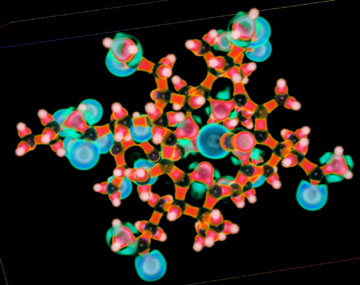 by Preston MacDougall November 14, 2005
So repeats the chorus of a new, techno-pop tune - "Girl" - by Beck Hansen, or simply Beck. If you've heard it, and couldn't understand what kind of girl, then join the club. Lately, it has been getting lots of play on a radio station that my children and I, their chauffeur, can agree on. It always starts a debate. To me, the romantic in the family, it sounds like "summer girl". To my son, the linguist and budding writer, it must be "sun-eyed girl" because he hears an n sound in the middle. My daughter, who is a pop and hip-hop aficionado, says she can't make it out, but likes the song anyway.
The liner notes for the "Guero" CD aren't much help either. There, you'll find that "My ... girl" is printed over and over. The chat room rumor is that she's his "cyanide girl", and that there are dark overtones to the song (which flew right past me). Glossy magazine interviews with Beck are less forthcoming. He simply says "It's kind of a love song, mixed in with some grit and some mystery." There's quite a bit of grit and mystery mixed in the chemistry of cyanide itself. When popular fiction readers hear "cyanide", they think of murder mysteries. In fact, cyanide is only half of a clue - with a single pair of carbon and nitrogen atoms, it is the negatively charged unit, or ion, of what are often very toxic salts. All salts must have an exact balance between the positive and the negative. For instance, potassium forms positive ions, and potassium cyanide is an example of a highly toxic salt - one that was once rumored to have figured prominently in the death of the great Berkeley chemist G. N. Lewis. (He actually died of a heart attack in his laboratory.) You might be surprised, perhaps horrified, to learn that, after all the visible nuggets have panned out, copious amounts of dilute sodium cyanide solutions are used to leach the valuable microscopic gold particles out of "them thar hills." To jewelers, the newly engaged, and those who can't get enough bling, the price of gold is approaching $500 per ounce. But to environmentalists, the cost is around 30 tons of ore that is scraped away, leached for its gold, and left in a toxic state. Cyanide isn't toxic forever, however, and sometimes it isn't toxic at all. Sunlight, combined with the oxygen in the air, will eventually cleanse such toxic sludge. But spills and leaks are possible, and hills are notoriously slow to regrow. Cyanide isn't toxic when its positive partner is the much larger cobalamin co-enzyme. In fact, it is good for you, especially if you are anemic. When you buy vitamin B12 from a pharmacy, you are in fact getting cyanocobalamin - a cyanide-containing compound. It won't do you any good, though, if it has been on the shelf too long, since it is sensitive to light and oxygen just like the toxic sludge. In a chemical refrain that is repeated over and over, our bodies are naturally prepared to deal with small doses of substances that are toxic in large amounts. In the case of cyanide, our bodies probably use the small amounts found in food (spinach and almonds are good sources) to make our own vitamin B12 - no charge. Instead of sodium, or gold, the first metal that latches onto cyanide in our bodies is cobalt. Cobalt sits beside iron on the periodic table, and often makes beautiful pink solutions, such as when it swaps places with sodium in its chloride salt. Cobalt glass is famously blue, but crystals of vitamin B12 are deep red in color. Not quite blood red, you need iron for that. Both iron and cyanide figure prominently in one of the first truly synthetic pigments. Many early pigments, such as indigo and Tyrian purple, are essentially extracted from plants or animals, and then chemically modified, but only marginally. In 1704 however, when chemistry was still a black art, and wars in Europe made exotic pigments hard to obtain, a German artist named Heinrich Deisbach teamed-up with a local alchemist and conducted a "strange brew" including dried ox blood, potash, and iron salts made from sulfuric acid. The result was Prussian blue, an immediate hit on the art scene and in printing presses. As chemical analysis matured, it became clear that the iron, carbon and nitrogen in the blood's hemoglobin (a very large and complex molecule) had become unglued and undergone wholesale atomic rearrangement, during a series of chemical reactions, some catalyzed by the caustic potash. Eventually, with the advent of X-ray analysis, it was determined that the blue color, which is unusual for iron, arises from simple ferrocyanide ions. Blue and gold are colors that one associates with top prizes: blue ribbons for stud-worthy racehorses or champion insurance salesmen, and gold medals for Nobel laureates or the best students at the International Chemistry Olympiad. Blue and gold are also the team colors of the Fighting Irish of Notre Dame, where, before a famous victory, Knut Rockne gave his "Win one for the gipper" pep talk. Less well-known may be the facts that before Knute Rockne made history on the gridiron at Notre Dame, he developed his logical reasoning in the laboratory as a chemistry student, and then perfected his teaching skills in the classroom, as a chemistry instructor, on the very same campus. Like a "raggedy love song", or a Hail Mary victory, chemistry itself is "grit and mystery".
|
||
